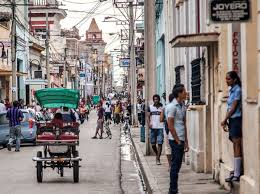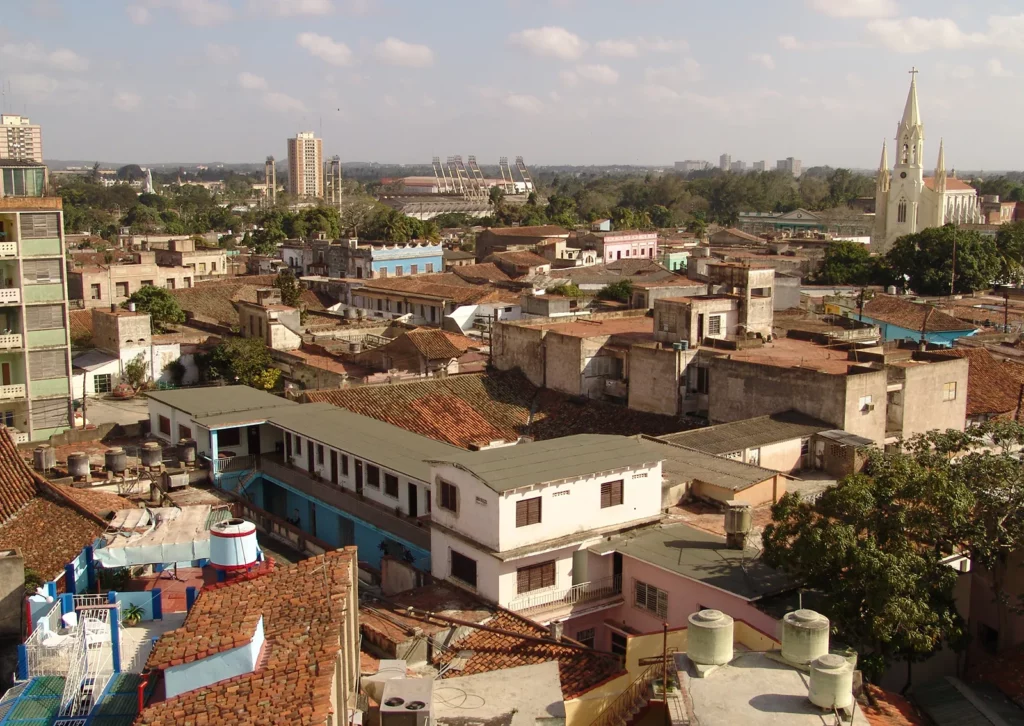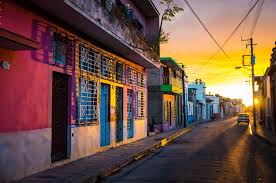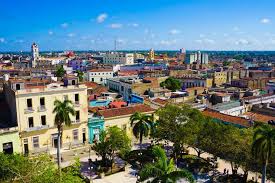
CAMAGUEY, CUBA, LA TERCERA CIUDAD MÁS GRANDE DE LA ISLA. LLAMADA “LA CIUDAD DE LOS TINAJONES”. FOTOS
Camagüey es una ciudad y municipio en el centro de Cuba y es la tercera ciudad más grande del país con más de 333.000 habitantes. Es la capital de Camagüey.
Camagüey es la provincia más oriental, más grande y más plana del centro de la isla de Cuba. Su economía creció durante el siglo XVII gracias a la producción de azúcar y la cría de ganado. Tiene algunos conjuntos montañosos y está flanqueado por los dos archipiélagos más grandes del país: al norte, Sabana-Camagüey, conocidos como los Jardines del Rey; y al sur, los Jardines de la Reina.
El símbolo de la ciudad de Camagüey es la vasija de barro o tinajón, utilizada para captar el agua de lluvia y mantenerla fresca. Camagüey es también la cuna de Ignacio Agramonte (1841), figura importante de la Guerra de los Diez Años contra España. Un monumento del escultor italiano Salvatore Buemi, erigido en el centro de la zona a Ignacio Agramonte, fue inaugurado por su esposa en 1912. Está compuesto por una estatua ecuestre, relieves en bronce que revelan fragmentos de la vida de Agramonte y una escultura. de una mujer que simboliza la patria.
HISTORIA
Camagüey fue fundada como Santa María del Puerto del Príncipe en 1514, por colonos españoles liderados por Diego Velázquez de Cuéllar en un lugar ahora conocido como Nuevitas en la costa norte. Fue uno de los siete asentamientos (villas) originales fundados en Cuba por los españoles. El asentamiento se trasladó tierra adentro en 1528 al sitio de una aldea taína llamada Camagüey. Es posible que la aldea haya recibido el nombre de un jefe local o quizás de un árbol endémico de la región.
La nueva ciudad se construyó con un diseño confuso de callejones sinuosos. Hay muchos callejones sin salida y calles bifurcadas que conducen a plazas de diferentes tamaños. Una explicación es que esto se hizo intencionadamente, para que la ciudad fuera más fácil de defender de cualquier asaltante; Según la misma versión, la razón por la que solo hay una salida de la ciudad es que si los piratas alguna vez regresan y logran ingresar a la ciudad, los habitantes locales podrían atraparlos y matarlos. Sin embargo, los lugareños cuestionan este razonamiento como un mito, afirmando que en realidad la ciudad se desarrolló sin planificación, y esas calles sinuosas se desarrollaron porque todos querían permanecer cerca de su iglesia local (la ciudad tiene 15).
GEOGRAFÍA
Ubicado sobre una llanura en el centro de su provincia, el municipio limita con Vertientes, Florida, Esmeralda, Sierra de Cubitas, Minas, Sibanicú y Jimaguayú.
DEMOGRAFIA
En 2004, el municipio de Camagüey tenía una población de 333.000 habitantes. Con una superficie total de 1.106 km2 (427 millas cuadradas), tiene una densidad de población de 293,8/km2 (761/millas cuadradas).
CULTURA
El símbolo de la ciudad de Camagüey es la vasija de barro o tinajón, utilizada para captar el agua de lluvia para luego aprovecharla manteniéndola fresca. Hay vasijas de barro por todas partes, algunas tan pequeñas como una mano, otras lo suficientemente grandes como para que dos personas se pongan de pie, ya sea como monumentos o para uso real. Una leyenda local dice que si bebes agua de un tinajón te quedarás en Camagüey (“Quien tome agua del tinajón, en Camagüey se queda”), es decir, que si conoces a una camagüeyense te enamorarás de ella. ella y nunca dejarla. Las principales instituciones de educación secundaria son la Universidad de Camagüey y el Instituto Pedagógico de Camagüey.
En julio de 2008, el casco antiguo fue declarado Patrimonio de la Humanidad por la UNESCO.
INFRAESTRUCTURA
El trazado de la ciudad antigua parece un verdadero laberinto, con calles estrechas y cortas que siempre giran en una dirección u otra. Después de que Henry Morgan quemara la ciudad en el siglo XVII, fue diseñada como un laberinto para que a los atacantes les resultara difícil moverse dentro de la ciudad.

TRANSPORTE
Camagüey cuenta con una importante estación ferroviaria en la línea principal Habana-Santiago con conexiones a líneas menores. La estación se encuentra en la céntrica “Avenida Van Horne”, en la esquina con la “Avenida Finlay”. La ciudad es atravesada por la Carretera Central y cuenta con una circunvalación. La autopista A1, que unirá La Habana con Guantánamo, y parcialmente construida, se encuentra en fase de proyecto en el área de la ciudad.
AEROPUERTOS
Camagüey tiene su propio aeropuerto internacional, el Aeropuerto Internacional Ignacio Agramonte ubicado en el suburbio noreste.
DEPORTES
El club de béisbol local es Camagüey, apodado Alfareros, y su estadio es el Estadio Cándido González. El club de fútbol de la asociación es el FC Camagüey y su estadio es el Estadio Patricio Lumumba.
EDUCATION
Instituto Pre-Universitario Vocacional de Ciencias Exactas
Although it is not the only high school in the City, the Pre-Universitario, sometimes referred to as “Vocational School” but formally known as “Instituto Pre-Universitario Vocacional de Ciencias Exactas” (IPVCE) Máximo Gómez Báez es: Instituto Preuniversitario Vocacional de Ciencias Exactas – or, in English, Vocational Pre-University Institute of Exact Sciences Máximo Gómez Báez – is the largest of its kind in the province of Camagüey. The size of the institution qualifies it as a “learning city”. This center is homologous to others existing in the rest of the country’s provinces. Students usually form close bonds and lasting friendships while at the institution, but family bonds sometimes suffer and “traditional” moral attitudes tend to shift as teenagers spend weeks away from their family. To be admitted into the IPVCE, students must take an entrance exam after completing the preparation of the Basic Secondary Education (7th to 9th grade). During the following three years they receive intensive preparation in order to gain acceptance to college.
OTHER HIGH SCHOOLS
What we know in the United States as High Schools (9-12 grade), in Cuba is called Secundaria from (7-9 grade) and Pre-Universitario from (10-12 grade). Some relevant Secundarias in Camagüey are La Avellaneda, Torre Blanca, Javier de la Vega, Ana Betancourt de Mora, Ignacio Agramonte, and many others. In Camagüey city, there are other high schools, as well as schools for athletes (ESPA, and EIDE), for artists (The School of Art), and the Military High School “Camilo Cienfuegos”.
UNIVERSITY
The University of Camagüey, with engineering and basic and humanitarian sciences programs, is located in the city. There are a separate university college for medical education (Carlos J Finlay University of Medical Science). Since 2016, the University of Camaguey is a blending between Sports University and Pedagogical Sciences University, counting over 12 000 students and 3 000 professors.
NOTABLE RESIDENTS
Camagüey is the birthplace of professional boxer Luis Ortiz (1979); birthplace of Ignacio Agramonte (1841); José Iraola, a contemporary painter; sculptor Roberto Estopiñán; Brígida Agüero y Agüero (1837-1866) and Domitila García Doménico de Coronado (1847-1938); Major League Baseball Hall of Fame member Atanasio Perez Rigal (Tony Pérez); poet Nicolás Guillén, and of Carlos J. Finlay, an outstanding physician and scientist; Mireya Luis, Gertrudis Gomez de Avellanada (poet), Silvestre de Balboa (1563–1649, writer), Salvador Cisneros Betancourt, Marqués de Santa Lucia (Cuban patriot, signatory of the Guaimaro Constitution of 1869 and President of the Cuban Republic in Arms); Olympic champion amateur boxer Jorge Gutiérrez Espinosa; Cuban writer Severo Sarduy, a member of the Cuban intellectual community.


CAMAGUEY, CUBA, IS THE THIRD LARGEST CITY OF THE ISLAND. CALLED “THE CITY OF LOS TINAJONES” (CLAY POT CITY). PHOTOS
Camagüey is a city and municipality in central Cuba and is the nation’s third-largest city with more than 333,000 inhabitants. It is the capital of the Camagüey.

Camagüey is the easternmost, largest, and flattest province in the center of the island of Cuba. Its economy grew during the 17th century thanks to sugar production and cattle breeding. It has a few mountain groups and is flanked by the two largest archipelagos in the country: to the north, Sabana-Camagüey, known as the Jardines del Rey (Gardens of the King); and to the south, the Jardines de la Reina (Gardens of the Queen).
The symbol of the city of Camagüey is the clay pot or tinajón, used to capture rainwater and keep it fresh. Camagüey is also the birthplace of Ignacio Agramonte (1841), an important figure of the Ten Years’ War against Spain. A monument by Italian sculptor Salvatore Buemi, erected in the center of the area to Ignacio Agramonte, was unveiled by his wife in 1912. It is composed of an equestrian statue, reliefs in bronze that reveal fragments of the life of Agramonte, and a sculpture of a woman that symbolizes the motherland.
HISTORY
Camagüey was founded as Santa María del Puerto del Príncipe in 1514, by Spanish colonists led by Diego Velázquez de Cuéllar at a location now known as Nuevitas on the northern coast. It was one of the seven original settlements (villas) founded in Cuba by the Spanish. The settlement was moved inland in 1528 to the site of a Taíno village named Camagüey. The village may have been named for a local chief, or perhaps for a tree endemic to the region.
The new city was built with a confusing lay-out of winding alleys. There are many blind alleys and forked streets that lead to squares of different sizes. One explanation is that this was done by design, to make the city easier to defend from any raiders; by the same version, the reason that there is only one exit from the city was that should pirates ever return and succeed in entering the city, it would be possible for local inhabitants to entrap and kill them. However, locals dispute this reasoning as a myth, asserting that in truth the city developed without planning, and those winding streets developed out of everybody wanting to stay close to their local church (the city has 15 of them).
GEOGRAPHY
Located on a plain in the middle of its province, the municipality borders with Vertientes, Florida, Esmeralda, Sierra de Cubitas, Minas, Sibanicú, and Jimaguayú.
DEMOGRAPHICS
In 2004, the municipality of Camagüey had a population of 333,000. With a total area of 1,106 km2 (427 sq mi), it has a population density of 293.8/km2 (761/sq mi).
CULTURE
The symbol of the city of Camagüey is the clay pot or tinajón, used to capture rainwater to be used later, keeping it fresh. Clay pots are everywhere, some as small as a hand, some large enough for two people to stand up in, either as monuments or for real use. A local legend is that if you drink water from a “tinajon”, you will stay in Camagüey (“Quien tome agua del tinajón, en Camagüey se queda”), meaning that if you meet a Camagüayense girl, you will fall in love with her and never leave. The main secondary education institutions are the University of Camagüey and the Instituto Pedagógico de Camagüey.
In July 2008, the old town was designated a UNESCO World Heritage Site.
INFRAESTRUCTURE
The old city layout resembles a real maze, with narrow, short streets always turning in one direction or another. After Henry Morgan burned the city in the 17th century, it was designed like a maze so attackers would find it hard to move around inside the city.
TRANSPORT
Camagüey counts an important railway station on the main Havana-Santiago line with connections to minor lines. The station lies in the central “Avenida Van Horne”, at the corner with “Avenida Finlay”. The city is crossed by the Carretera Central highway and counts a beltway. The A1 motorway, which will link Havana to Guantánamo, and partly built, is in the project phase in the city area.

AIRPORTS
Camagüey has its own international airport, Ignacio Agramonte International Airport located in the north-eastern suburb.
SPORTS
The local baseball club is Camagüey, nicknamed Alfareros, and its home ground is the Stadium Cándido González. The association football club is FC Camagüey and its home ground is the Stadium Patricio Lumumba.
EDUCATION
Instituto Pre-Universitario Vocacional de Ciencias Exactas
Although it is not the only high school in the City, the Pre-Universitario, sometimes referred to as “Vocational School” but formally known as “Instituto Pre-Universitario Vocacional de Ciencias Exactas” (IPVCE) Máximo Gómez Báez es: Instituto Preuniversitario Vocacional de Ciencias Exactas – or, in English, Vocational Pre-University Institute of Exact Sciences Máximo Gómez Báez – is the largest of its kind in the province of Camagüey. The size of the institution qualifies it as a “learning city”. This center is homologous to others existing in the rest of the country’s provinces. Students usually form close bonds and lasting friendships while at the institution, but family bonds sometimes suffer and “traditional” moral attitudes tend to shift as teenagers spend weeks away from their family. To be admitted into the IPVCE, students must take an entrance exam after completing the preparation of the Basic Secondary Education (7th to 9th grade). During the following three years they receive intensive preparation in order to gain acceptance to college.
OTHER HIGH SCHOOLS
What we know in the United States as High Schools (9-12 grade), in Cuba is called Secundaria from (7-9 grade) and Pre-Universitario from (10-12 grade). Some relevant Secundarias in Camagüey are La Avellaneda, Torre Blanca, Javier de la Vega, Ana Betancourt de Mora, Ignacio Agramonte, and many others. In Camagüey city, there are other high schools, as well as schools for athletes (ESPA, and EIDE), for artists (The School of Art), and the Military High School “Camilo Cienfuegos”.
UNIVERSITY
The University of Camagüey, with engineering and basic and humanitarian sciences programs, is located in the city. There are a separate university college for medical education (Carlos J Finlay University of Medical Science). Since 2016, the University of Camaguey is a blending between Sports University and Pedagogical Sciences University, counting over 12 000 students and 3 000 professors.
NOTABLE RESIDENTS
Camagüey is the birthplace of professional boxer Luis Ortiz (1979); birthplace of Ignacio Agramonte (1841); José Iraola, a contemporary painter; sculptor Roberto Estopiñán; Brígida Agüero y Agüero (1837-1866) and Domitila García Doménico de Coronado (1847-1938); Major League Baseball Hall of Fame member Atanasio Perez Rigal (Tony Pérez); poet Nicolás Guillén, and of Carlos J. Finlay, an outstanding physician and scientist; Mireya Luis, Gertrudis Gomez de Avellanada (poet), Silvestre de Balboa (1563–1649, writer), Salvador Cisneros Betancourt, Marqués de Santa Lucia (Cuban patriot, signatory of the Guaimaro Constitution of 1869 and President of the Cuban Republic in Arms); Olympic champion amateur boxer Jorge Gutiérrez Espinosa; Cuban writer Severo Sarduy, a member of the Cuban intellectual community.

Agencies/ Wiki/ CamagueyCuba/ Extractos/ Excerpts/ Internet Photos/ Arnoldo Varona/ www.TheCubanHistory.com

THE CUBAN HISTORY, HOLLYWOOD.


